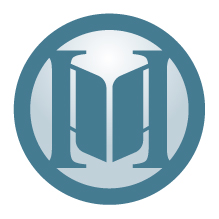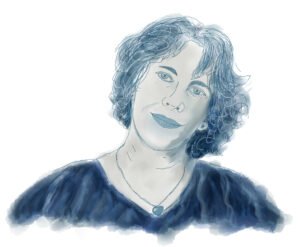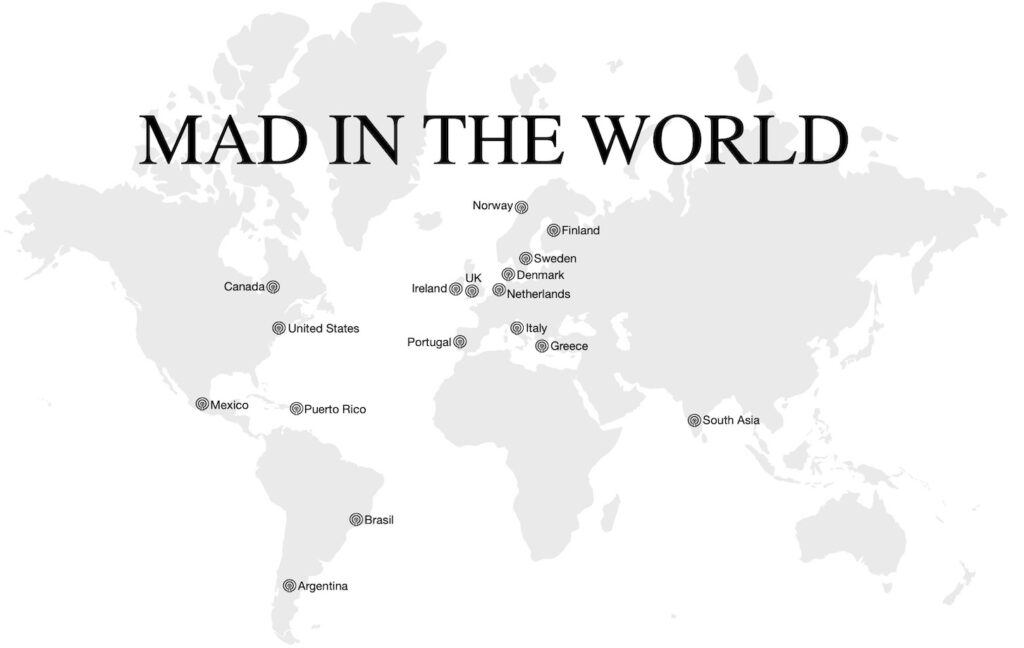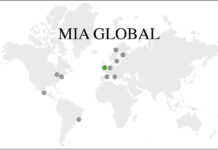Smack at the top of the Mad in the Netherlands homepage sits a logo that looks lit from within—a grayish-blue image framed by sturdy posts and a hinged pair of doors. It could be an “M,” or a gate.

In fact, it’s both.
“We had a very clear goal of being a kind of gateway that provides access to international knowledge and information about psychiatry,” said founder and editor Monique Timmermans via email. “Our logo expresses both the ‘M’ of the Mad family and that gateway. With the colors, we try to radiate professionalism. We also subtly symbolize to shed a different light on existing paradigms.”
She and her husband came up with the idea—and her brother, who has an advertising studio, helped realize it. The logo captures the essence of Mad in the Netherlands, a freshly launched MIA affiliate that strives to connect Dutch readers with critical research and insights from around the world.

That’s a considerable undertaking.
For one thing, Timmermans explained: In the Netherlands, the psychiatric system is heavily influenced by the biomedical narrative and just as heavily reliant on the Diagnostic and Statistical Manual. Long-term prescriptions are common; so are waiting lists; so is victim-blaming. Holistic treatments are hardly covered by insurance.
For another: Research and other resources on psychiatric drugs are not easily available in Dutch. Timmermans isn’t sure why. If you feel fine within the established treatment, plenty of information is available. “But when the guidelines do not suit you and do not match your feelings, it becomes complicated to find alternatives or to find peer support that brings empowerment,” she said. Further, they might not know how to look—which search terms to use, which websites to access. A patient might be on antipsychotics and in agony with restlessness, “But if you don’t know the word ‘akathisia,’ what are you searching for?”
Enter Mad in the Netherlands, which gives readers an entryway into an alternate conversation about mental health and the science challenging the current paradigm for care.
“The prerequisite for being able to find other paths is the awareness that other paths exist,” Timmermans wrote. “That is why we open the gate.”

Timmermans answered questions via email and Zoom, discussing both the origins and aims of the new MIA affiliate and her own personal journey. She has 10 years of lived experience as a patient diagnosed with psychosis, PTSD, and anxiety—“but, in retrospect, I believe the main problem was disturbed grief” following the death of her premature daughter. As she described it, “A lot went wrong during the farewell, causing confusion and seriously disrupting the grieving process.” That disruption continued, and she ended up in psychiatric treatment.
After 12 years, feeling recovered, she resolved to taper off her antipsychotics and proceeded more slowly than the guidelines indicated. A few weeks after the last pill, she developed tardive dystonia, tardive dyskinesia, and tardive akathisia—without knowing what they were.
“I was in a constant horrible state of pain, restlessness, and overwhelming excitement,” she wrote, “and had no idea what was happening to me. It was incredibly frustrating that I could not find help in the Netherlands at all. The ‘professionals’ who knew just fine how to prescribe medication knew nothing about safe tapering and even less about tardive withdrawal symptoms.”
Then, after around nine months of searching, she found a video by the Danish psychologist and psychiatric survivor Olga Runciman. Googling some more, she found Mad in America—“and a whole new world literally opened up for me.” She realized an “enormous amount of knowledge and material available worldwide,” and she decided to make it available to other Dutch-speakers on a similar quest to understand.
As she put it: “I want to spare other people with similar complaints an endless search by putting them on the right track through Mad in the Netherlands. Once you have found that first site, you can use the links and search terms from that site to find whatever you are looking for.”
In April of 2020, Timmermans emailed Mad in America about starting an affiliate. Ten months later, on February 1, Mad in the Netherlands kicked off with an array of content designed to highlight research and open up access to other platforms around the globe. The site includes, for a start, a pharmaceuticals resource page; a section devoted to articles translated (in whole or in part) from Mad in America and other sources; a “quarterly theme” page currently focused on Adverse Childhood Experiences (ACE); and a page linking to other global and Dutch information sources.
“The goal of our website is to make global knowledge findable,” she wrote in her email. “We hope that patients, their loved ones, and practitioners will use our website to broaden their view on psychiatry by providing them sources of information that enables them to make informed choices.”
What Mad in the Netherlands doesn’t publish: Her own blog posts. In general, she said, the Dutch prefer “evidence-based” and “down-to-earth” arguments over discussions based on personal feelings—so science is what she emphasizes on her site.
Besides, she said, there are plenty of other, excellent sites out there that provide a platform for people with lived experience: “The Hearing Voices community, the Open Dialogue community.” Once again, “I’m just the gate. Okay, so you want to withdraw? Go to Inner Compass. You want to talk about dystonia? Go to the Dystonia Foundation.” There’s no need to reinvent the wheel.
As for funding, Timmermans is determined to remain as independent as possible. She doesn’t want Mad in the Netherlands to compromise in its coverage; she also doesn’t want anyone to suspect it of being compromised. Besides the basic resources offered by Mad in America, she wrote, “We run on a budget of € 0. People who write, illustrate or translate for us act from idealism.”
Besides Timmerman’s husband (John Timmermans) and brother (Joris de Mol), Mad in the Netherlands benefits from contributions of illustrator Annemarie van Essen and several translators, including Joost Roompa—who also helps with article selection. In addition, the affiliate asks specialists on particular topics to review relevant pages—so, for instance, a trauma-informed therapist took a close look at the ACE page.
What’s missing, right now, “is someone who can spend more time to raise awareness on social media. Because our team is still small, we cannot be as interactive as we would like.” That’s one of the affiliate’s goals moving forward. Another is to “strengthen the call for change” in the Netherlands, amplifying the work of those who advocate for new mental health care “with less fixed rules and more room for the human side,” she said.
Just a few weeks after its launch, MadintheNetherlands.org has had 600 unique visitors and 2,000 pageviews—an early indicator of impact. Another indicator is positive reader responses on social media, mostly from patients. In the future, Timmermans hopes to reach professionals as well. And they, she hopes, can push for reform.
Diplomacy is the key, she added—citing polder, a Dutch model of cooperation named after the system of dikes and mills that control flooding in low-lying areas. “If you want to change something, you must stay on speaking terms with people you want to change.”
She reflected, again, the grief that began her journey—and then the second grief that hit her later, in her search for information, when she realized that most of what she’d been told was wrong. Running the affiliate now “is giving value to the grief. So it wasn’t for nothing, all those years of fighting.”
There’s so much division everywhere, she said—so much isolation and failure to connect. “We all have things that happened in our lives, and we all think we are the only one that has such a story.”
In connecting with others, we know we’re not alone. And as she learned playing volleyball, team spirit is important. It provides connections, meaning, refuge, and strength. The MIA community offers the same, she said.
“That’s what I think is the power of Mad in the World. . . What if we all band together, and we are fighting the same fight? Then we are much stronger.”
*****
MIA Editors: Over the next 10 weeks, we will be publishing a profile of each of the Mad in America affiliates. They have banded together as a “Mad in the World” network.















The Netherlands has a very weird concept enshrined in their law. It’s known as “duty-to-die”. The basic idea, is that if your care is too expensive to the State, and you are no longer a “productive citizen”, then you have a “duty-to-die”, and save the State all the expense of caring for you. As long as several years ago now, a teenage “mental patient” was allowed State-assisted-suicide to alleviate her “treatment-resistant-depression”. God, I wish I was making this stuff up. They ALSO have Dr. Jim Van oS, (do I remember his name correctly?…), so there’s some balance, too…..
Other than that, KEEP UP the GOOD WORK, MiA….
Report comment
Bradford,
I have witnessed people (in genuine peer support fellowship) recover all the time.
Report comment